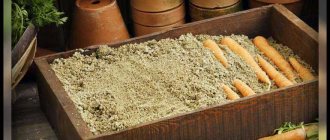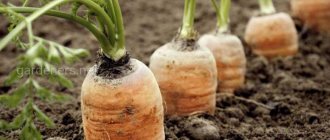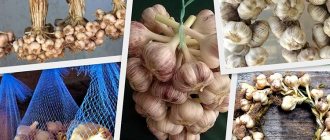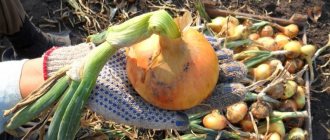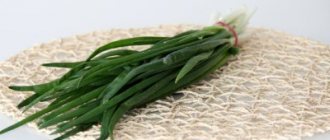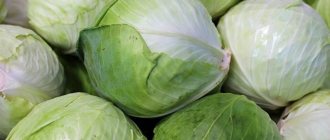Proper storage of carrot harvest is a difficult problem for gardeners. It is especially acute in the absence of basements and cellars.
One way to solve the problem is to keep the carrots in the ground until spring. With proper organization, root crops can easily survive even severe frosts.
Let’s take a closer look at how to properly store carrots in the ground until spring.
Storing root vegetables: myth or reality?
Preserving vegetables throughout the winter is quite possible if appropriate conditions are created so that the vegetables do not spoil or lose their taste.
Carrots are a cold-resistant crop and do not lose their quality even with slight frosts in the autumn. This quality allows you to even leave the crop on the ground.
Storage conditions for carrots:
- humidity – about 95%;
- temperature – about 0ºС.
In addition to compliance with external conditions, requirements are also imposed on the vegetable itself:
- late-ripening variety;
- achieving full maturity;
- absence of physical damage and illness.
The vegetable itself has a thin peel that is susceptible to external influences. If the storage organization technology is violated, root crops begin to lose natural moisture and deteriorate.
Growing carrots for long-term storage correctly
Round-shaped carrots with thick skin are stored well.
Round-shaped carrots with thick skin are suitable for long-term storage. Even in the spring, you can choose several varieties for planting at once. One will be used for autumn harvesting, the other for long-term storage.
The soil for storing carrots should not be very oily. Of course, when fertilized with humus and manure, the root crops will grow large, but they will lie very poorly.
Stop watering three weeks before the expected harvest.
Carrots intended for storage should be watered evenly. If you flood the beds with water after a long drought, the root crops will crack. Such a harvest will have to be consumed immediately and as quickly as possible. It is worth stopping watering about three weeks before the intended harvest, so that the vegetables do not absorb excess moisture and are stored longer.
It is advisable to harvest after the first light frost. Then all processes in the root crop are suspended and go into “hibernation” mode. Such carrots, if the temperature is maintained, will not germinate until spring. After the crop has been dug up, you should immediately cut off the tops, leaving a very small petiole. Otherwise, during the drying process, moisture will evaporate through the leaves and the root crops will wither.
There is no need to try to thoroughly clean the entire crop from the soil; you can accidentally damage the skin and rotting processes will begin.
Only whole and healthy carrots are selected for storage.
All root vegetables must be carefully inspected and sorted. Damaged and cracked specimens should be immediately set aside for immediate use.
Only whole and healthy carrots are selected for storage. It is also advisable to separate large representatives from small ones. The smaller the root crop is in volume, the faster it will begin to wither. Therefore, it is better to use it first.
Before storing, while the carrots are drying after harvesting, they can be processed. Pour a red manganese solution into a spray bottle and spray the entire crop.
Choice of variety and preparation features
Not all varieties are suitable for storage in the ground, but only late ripening ones, including hybrid ones. They must be adapted to climatic conditions and have good cold resistance.
The most popular among them include:
- Shantanay;
- "Incomparable";
- Royal Chantanay;
- Perfection;
- Sirkana F1 and others.
The choice of carrot seeds, which are intended for storage in the ground, should take into account the characteristics of the growing area.
Even at the stage of choosing a place for a garden bed and seeds, it should be taken into account that the crop will remain in the ground throughout the winter. Requirements for the site:
- The territory should not be in a zone of flooding with water (groundwater or as a result of heavy rainfall).
- Protection from rodents is required.
- The shelter must be secure enough to prevent the soil from freezing.
- The soil should not be infested with pests.
- The area for carrots should not interfere with spring sowing.
Even if the unharvested, unsheathed and unharvested carrot crop is caught in frost, the harvest is not in danger.
There are 2 ways to preserve carrots in the ground without using a special room:
- Directly on the garden bed.
- In a hole in the ground.
Each of the presented options has its own pros and cons.
Peculiarities
Each farmer has chosen for himself the optimal and suitable method of storing the crop. But what to do if you live in an apartment and there are no basements available. There are several options for storing root vegetables in an apartment for a long time.
Can this be done at home? Yes, and the most optimal place to store crops in an apartment is the balcony. Carrots are very whimsical; they do not like excessive amounts of light, moisture and humidity. For storage, the harvest is not young and not too ripe.
Reference. If the quantity of vegetables is small, they can be stored in the refrigerator.
How to properly store crops in the garden?
Since carrots are resistant to low temperatures, they can be left directly in the garden bed where they grew. In winter, severe frosts are possible, so it is better to organize additional shelter.
This method is acceptable under the following conditions:
- there is no time to harvest;
- there are no conditions for storage - there is no cellar or other suitable room.
Disadvantages of storing vegetables in the ground unharvested:
- possible damage to root crops by rodents;
- there is a possibility of damage to the crop by pests remaining in the soil;
- there is no confidence that all the vegetables left in the beds are of good quality, since it is impossible to inspect them before storage;
- In very snowy winters it can be difficult to get to the carrots.
To create a shelter right in the garden you will need:
- black polyethylene;
- roofing felt;
- boards or sand.
Procedure:
- Eliminate weeds in the carrot bed.
- If the tops remain green until late autumn, they need to be cut off. The tail that remains should be no more than 20-30 mm.
- Place a row of boards on top or pour wet sand in a layer of 20-30 mm.
- If the option with sand is chosen, then a layer of black polyethylene is placed on top of it before the onset of frost.
- Add a layer of mulch.
- Cover with a layer of film and roofing felt to protect against low temperatures.
It is necessary to ensure that the coating is well secured; it must be resistant even to strong gusts of wind.
At what temperature can carrots be stored on a balcony or glassed-in loggia?
The temperature at which carrots retain vitamins, minerals and taste is from 0 to + 1 C with a humidity of 85-90%. Make sure it doesn't go any lower. When frost sets in, bring it indoors. The permissible temperature when storing on the balcony is from + 1 to + 8 degrees. If the temperature on the balcony is sub-zero, the carrot juice will freeze. After the temperature increases, all the juice will begin to flow out through the cracks in the root crop formed due to ice. Through the cracks, all kinds of infection will penetrate into the vegetables, which will lead to rotting of the carrots.
If the temperature rises above +8 degrees, the carrots, due to the acceleration of metabolism, will begin to sprout or rot. At temperatures above + 8 degrees, the vegetable will begin to dry out and simply wither. Ventilation on the balcony should be weak, because along with fresh air, bad microorganisms that cause diseases will penetrate. When the humidity percentage changes, the carrots will quickly dry out and wilt.
Vegetables with thin skin require more careful handling. It cannot be washed or cleaned.
Leave it in a hole for the winter
The method of storing carrots in an earthen pit involves preliminary digging up the crop. This option for preserving root crops can be adopted in the absence of storage space.
To extract carrots
you will need the following tools:
- pitchfork;
- sharp knife.
Using a shovel is not advisable, as this increases the likelihood of damaging the tubers.
The procedure for carrying out harvesting work:
Using a pitchfork, dig up the carrots as carefully as possible.- Dry the carrots.
- After drying, sort the carrots. Only large and even ones will go into storage.
- Use a knife to cut off the tops, leaving no more than 30 mm.
- Putting into bags. This item is not required if bulk storage is intended.
In the process of digging up crops, rough mechanical impact on root crops should be excluded, since even minor damage can negatively affect the quality of crop preservation.
After the carrots are prepared, you need to take care of creating an earthen pit. To carry out the work you will need:
- shovel;
- sand (coarse) or straw;
- boards;
- slate;
- rodent mesh.
Work order:
- A hole is dug. Its depth is determined by climatic conditions. For severe frosty winters - 100 cm, for not severe ones - 50 cm. The width should be about 50 cm. The length is determined by the volume of the harvest.
- Cover the bottom of the hole with wet sand. If it is not available, you can use hay. The main requirement when creating such a “pillow” is to avoid contact between the carrot and the soil.
- Laying a mesh with small cells to protect against rodents.
- Cover the walls of the trench with boards.
- Plant carrots. Sprinkle the layers with straw or sand. In this case, there should be a gap of about 20 cm from the soil surface.
- Place a layer of soil on top of the last layer of sand or straw.
- Add mulch or pine needles to create insulation.
- Apply slate.
- Dig a shallow trench around the storage facility to drain water.
A wooden box for ventilation can be installed in the central part of the pit.
Advantages and disadvantages
Carrots in sand can be stored both in a cellar or garage pit, and on a regular balcony. The main rule is a large distance from heating radiators.
What other advantages of this method:
The material draws out excess moisture and keeps the fruits dry.- The sand “insulates” the carrots if the cellar is cold, or cools them if warm air penetrates into the cellar.
- The shelf life of carrots is 6-8 months.
Disadvantages include the stickiness of wet sand to the fruit (the carrots will need to be washed additionally before peeling), the cost of effort and time.
Duration
The shelf life of vegetables depends on compliance with all conditions. If all the rules are followed, root vegetables are well preserved until warm spring days.
The following factors can affect the reduction in duration:
- access to rodent products;
- flooding;
- poorly organized shelter, as a result of which vegetables freeze;
- soil contamination by pests.
Vegetables dug from an earthen hole or from beds are not stored in the open air for a long time. In this regard, it makes sense to take out no more carrots than necessary. In the second year, these vegetables begin to lose their taste.
Preparatory stage
Preparing carrots for storage is a very important stage. For successful preservation of root crops, it is necessary to correctly and timely harvest. Each variety has its own ripening period. Over-ripened carrots in the ground will receive an excess of nutrients and will become a tasty morsel for pests, while unripe ones will not accumulate the full amount of vitamins, which will affect the taste.
Important! You can determine the ripening of the fruit by the tops; if the lower leaves begin to turn yellow, then the crop is ready for harvest. The harvest must be harvested before the first frost.
- After harvesting, it is necessary to trim the tops to preserve moisture and beneficial vitamins and dry them in the sun for 2-3 hours.
- Cut off the top of the leaves with a sharp knife, leaving 1 cm.
- Before storing, the vegetable is kept for a week at a temperature of 10-15 degrees. During this time, the cutting areas are tightened, and diseased and spoiled vegetables give themselves away.
Root vegetables that are firm and without damage are selected for storage; the rest are used immediately.
Recommendations
Simple tips will help you avoid common mistakes and save your harvest:
- When leaving carrots in the garden bed during the winter, the tops should not only be cut off, but also removed from the garden bed. If left, the roots may begin to rot.
- The following can be used as mulch for insulation: straw, sawdust, hay, etc.
- The smell of pine needles can repel annoying rodents, so it is advisable to place pine paws along the perimeter around the storage area.
- The presence of sand in the soil helps to better preserve the crop. Sand also prevents the development of dangerous diseases that lead to rotting.
- The carbon dioxide released by carrots during storage contributes to better storage of vegetables.
Cellar storage
You can store carrots in the cellar in several proven ways.
In the sawdust
The cellar is an excellent option for storing various vegetables. Sawdust helps preserve them longer and better.
To store vegetables this way you need boxes. Sawdust is poured onto the bottom of each container, and root vegetables are laid out on top - their contact is excluded. The laid out layer of carrots is covered with sawdust, then a layer of root vegetables is laid out again, which is again sprinkled with sawdust. This way you can fill the boxes to the top in layers.
Root vegetables sprinkled with sawdust can be stored for up to a year. It is better to use coniferous raw materials. It contains more phytoncides that prevent the germination of vegetables, as well as some of their inherent diseases (viral diseases, fungus).
In sand
The principle of storage in sand is the same as in sawdust. You can sprinkle vegetables with both dry and wet sand. In addition to boxes, it is convenient to use buckets and pans.
To store vegetables, clay sand is needed; river raw materials are not suitable for such purposes. It is better to use moistened sand - mix dry raw materials with water in equal volume. You can ensure long-term freshness of carrots and prevent the growth of bacteria by adding chalk to wet sand.
Carrots sprinkled with sand can be stored for up to 8 months. You can extend this period by adding ash to the sand.
If there are no suitable storage containers, carrots can be stacked in pyramids. First, you need to pour a thick layer of sand on the floor, then lay a row of carrots on it. Sprinkle it with sand and lay out the next row of carrots, but in a checkerboard pattern. Using this algorithm, you can make pyramids up to a meter high. The sand should be slightly moistened.
In plastic bags
This storage option is appropriate if the cellar is dry enough. If humidity levels are high, vegetables will spoil quickly.
For this storage option, you need polyethylene bags of 5-25 kg. Garbage bags are also suitable for such purposes, but it is better to take transparent bags so that it is convenient to monitor the condition of the carrots.
There is no need to tie bags with carrots, otherwise the root crops will spoil due to the high accumulation of carbon dioxide. The bags can be tied, but in this case it is necessary to make holes in them where air will flow.
Instead of plastic bags, you can use cling film. Vegetables must be washed and dried. You need to wrap root vegetables in 3-5 pieces (depending on the size of the fruit), a larger number will lead to rapid spoilage of the product.
The presence of condensation on the bags indicates that the humidity level in the room is high. In such conditions, root crops will begin to deteriorate. Slaked lime, which should be scattered next to the bags, will help to avoid this trouble. It will absorb excess moisture.
In the moss
The attractiveness of moss for storage is due to its preservative effect. Such raw materials ensure the correct amount of carbon dioxide in the storage tanks. Another advantage of moss is that it weighs little, so if necessary, transportation will not cause any particular difficulties.
Moss for storing vegetables must be dry. Root vegetables do not need to be pre-washed, but they should be dried under natural conditions. After drying, place the vegetables in a cool place and keep there for a day.
For storage, root crops with moss are laid in layers - the algorithm is the same as in the case of sawdust or sand.
In the peat
Peat for storing carrots should be crumbly and slightly decomposed. Optimal humidity is 40-50%.
As in the case of sand and sawdust, vegetables with peat are laid in layers. A wooden box or cardboard box is suitable for this. First lay out a layer of peat, then a layer of vegetables without the root vegetables touching each other. Repeat alternation until the top of the container.
Peat allows root vegetables to remain elastic and juicy for a long time.
In enamel pans
Vegetables for such storage must be dry and clean. The tops must be trimmed and the carrots dried in the sun.
The fruits are placed vertically in the pan and covered with a dry cloth or paper towels. Be sure to cover with a lid.
Vegetables in enamel pans can be kept in the cellar or on the balcony. A prerequisite is a cool place and high humidity.
Clay pouring
Clay prevents root crops from withering and sprouting throughout the winter. Preparing the clay solution takes several days. You need to act according to the following algorithm:
- Fill the bucket halfway with clay, dilute with water, and leave for a day to swell.
- Stir the mixture, add more water, leave for several days - there should be a 2-3 cm layer of water on top.
- The consistency of the finished solution should be no thicker than sour cream.
For clay storage, boxes are needed. The bottom of each container should be covered with polyethylene (film, cut bag). Place a layer of root vegetables so that they do not touch. This layer must be doused with clay mortar and wait until it dries. Then lay out another layer of carrots and cover it again with clay filling. Following this algorithm, you can fill the box entirely. A prerequisite is to dry each layer.
Dipping in clay solution
It is simple to prepare a solution for such storage. It is enough to dilute the clay with water to obtain the consistency of liquid sour cream, but the solution should not drain from the vegetables.
You should not wash carrots before processing. After dipping, the root vegetables should be placed in a well-ventilated place to dry. They can be stored in wooden boxes or cardboard boxes.
Storage in lime
Slaked lime is used for storage. It is necessary to dilute the raw material 1:10 to obtain a creamy consistency. Carrots must be thoroughly dried before processing. Each root vegetable should be dipped in lime mortar and the excess mass should be allowed to drain off.
Carrots treated in this way should be placed in a well-ventilated area for 1-2 days. When all the root vegetables are dry, put them in a large box and close the container. This treatment prevents the fruit from withering and rotting.
Storing in chalk powder
Another way to store vegetables for as long as possible is chalk. The product must be in powder form. For 1 kg of vegetables, 20 g of chalk powder is required. Root vegetables must be thoroughly dried before processing. Each fruit must be powdered, then placed in boxes for further storage.
Is it possible in autumn and winter?
Carrots are sensitive to temperature and humidity. Therefore, when choosing a balcony for storage, it is necessary to create conditions in which it does not freeze, overheat, or dry out.
In autumn, root vegetables can be stored on an open balcony. In this case, you need to monitor the weather.
If nighttime temperatures begin to drop below freezing, additional measures must be taken to warm up the crop. On the open balcony, fresh carrots can remain until frost.
The harvest can be left to overwinter on the glassed-in loggia, but only on condition that the temperature there does not drop below -3 degrees.
Preparation for the process
The harvested crop, as well as the filler itself, requires pre-treatment. This directly affects the storage duration. Proper preparation consists of several activities.
Drying, washing, hardening of root crops
The above-ground part of the harvested carrot is cut off, leaving a tail no more than 2 cm long . The tops are cut off as quickly as possible after harvesting - in the first two hours, otherwise the green phytomass draws moisture from the root.
You can tear off weak tops with your hands. It is more convenient to cut stronger rods with a knife or scissors.
Next, the root vegetables are left in the air to air dry. If the weather permits, the root vegetables are laid out in the shade in the open air.
On rainy days, drying is carried out under a canopy or indoors. After this, the carrots are calibrated, selecting large specimens that have not been damaged by shovels or pests. Specimens with green tops are also removed for recycling.
At the same time, the remaining soil is removed from the surface of the root crops . This is done with a brush or rag. It is highly undesirable to use sharp objects (knife, spatula), as they can damage the delicate skin.
Cuts, breaks, and damage to root crops are “open gates” for fungal infection.
Two days before laying in the sand, root vegetables must be cooled . The temperature can be lowered gradually or sharply - this moment does not affect the degree of hardening. The required value is zero degrees.
Most experts are inclined to believe that washing carrots before placing them in sand is inappropriate.
Dry or wet litter?
A loamy substrate is suitable for storing plant products. It is not recommended to use sea sand due to the increased amount of salt .
To prevent infection of vegetables, the filler is pre-disinfected. To do this, it is calcined over an open fire in a fireproof container or spilled with a strong solution of potassium permanganate.
In the latter case, the sand must be dried to the optimum moisture content. If the filler has already been used in the previous year, it can also be used again to fill the root crops.
Carrots require a humidity of 90 to 96% . If this indicator falls, then the vegetables wither. It must be taken into account that during storage the root vegetables themselves release a certain amount of moisture during respiration.
It needs to be replenished. This is why the sand should always be slightly damp. Under normal conditions, one ton of carrots evaporates up to 16 grams of moisture.
The optimal filler is a moistened sand mixture that maintains friability . To achieve this condition, sand is moistened at the rate of 1 liter of water per 10 kg.
This is enough if the temperature in the vegetable storage is maintained from 0 to +3 degrees and the humidity is 95%.
If conditions are drier, the sand is moistened more. In very humid rooms it is recommended to use dry filler.
Which container to choose?
Suitable for long-term storage:
- wooden boxes,
- metal buckets,
- plastic containers.
The storage container can be made of brick without using mortar. Temporary masonry is convenient because it allows you to lay out a “box” of the desired size.
Containers are washed and disinfected using lime or copper sulfate. If the container has already been used for storing vegetables and there are traces of fungus on it, disinfection is required.
